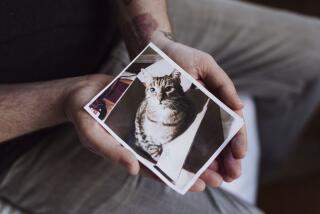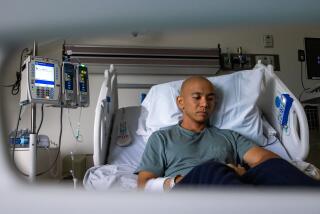âPatientâ Submits Blood (From Cat), Is Given Diagnosis
Some diagnostic methods used by Tijuana clinics that cater mainly to Americans appear as bizarre as the treatments offered.
Upon request, the Rosarita Beach Clinic, run by naturopath Don Gary Young, sends a prospective patient a kit with sharp pins and two glass slides. The patient is directed to puncture the little finger of each hand and make five blood spots on each slide, one for the left hand and one for the right. The slides are then mailed along with $60 to the clinic for diagnosis.
A Times reporter prepared two slides, using blood from a healthy 7-year-old, 20-pound tabby cat named Boomer that belongs to Glendale veterinarian Ahmed Kalek. The slides were presented at the clinic by the reporter who identified himself as a prospective patient.
Sharon Reynolds, âhealth educatorâ at the clinic, who also casts horoscopes for patients at $50 each, examined the slides under a microscope that projects an image on a television monitor. She said she found evidence of âaggressive cancerâ in the cells as well as liver problems.
The cancer, she said, had been in the reporterâs system for four or five years.
âYou must have suspected something,â she said, gazing up with sorrowful eyes.
The reporter said he had not suspected anything and suggested that another âblood crystallizationâ test be conducted that day. This time his own blood was used and Reynolds found signs of âlatentâ cancer but no evidence of âaggressiveâ cancer. She said that liver dysfunction was still evident as well as pancreas and thyroid problems.
She suggested another test be done in the near future and said in her report:
âElevated level of toxicity must be reduced in order to promote assimilation, increase oxygenation and prevent degeneration. We recommend a supervised program of cleansing, detox and rebuilding.â
The detoxification program at the clinic, which consists of colonics, a special diet and various nostrums, costs $2,000 per week, payable in advance. An at-home program is also available for $90 plus about $400 worth of vitamins and supplements that Young sells through his vitamin company in California.
The Times mailed a third set of slides for the follow-up test suggested by Reynolds. This time blood from a chicken in a Chinatown poultry shop was used.
Red cells in chicken blood are oval-shaped and have no nuclei--distinctly different from the round non-nucleated red cells in the blood of mammals when viewed under a microscope, experts say.
Nevertheless, the Rosarita Beach Clinic diagnosed the chicken blood as if it were from a human.
âThere is inflammation in the liver,â the clinicâs report said. âYour blood is indicating the possibility of a pre-lymphomic (sic) condition. It appears as though youâve recently undergone a high level of upset in your life which has weakened your immune response considerably.â
It closed with the earlier prescription for detoxification, word for word.
Dr. Faramarz Naeim, head of hematopathology at the UCLA Medical Center, was asked by The Times to look at the cat and human blood slides as well as a chicken blood slide similar to the one sent to the clinic.
Naeim, who was told nothing about the blood, immediately asked about one slide:
âIs this human blood? It looks like chicken blood.â
Naeim also said that blood slides used for valid diagnostic purposes must be thinly smeared and stained so that individual cells can be clearly seen under a microscope. Naeim and other blood analysts point out that information from such examinations is limited and is normally used in conjunction with other medical data in reaching a diagnosis.
âJust Drops of Clotted Bloodâ
The blood on the slides prepared for the Rosarita Beach Clinic was not smeared or stained and the cells are lumped together.
âThey are just drops of clotted blood,â he said.
Of the clinicâs written diagnoses, he said:
âThis is just garbage. It just contains words and terminology without making much sense. . . . Itâs crazy.â
Sharon Reynolds, Rosarita Beach Clinic health educator, later defended her analysis of the chicken blood in a telephone interview.
âI have never seen chicken blood before, so I wouldnât know,â she said. âIf that had been human blood that would have been an accurate analysis of the blood.
âThis is not a test where we see things in any way that a (conventional) blood test sees them,â she continued. âI analyzed it in good faith. . . . As warm-blooded animals apparently we have things in common.â
As for Boomer the cat, Reynolds insisted that, âIt was not a healthy cat. That cat probably has leukemia. . . . If the cat is acting healthy, the cat could be a carrier of leukemia.â
Mary Nightingale, assistant to veterinarian Kalek, said Boomer was tested for leukemia after the clinic diagnosis and was found to be neither afflicted with nor carrying the disease.
Sometimes, the âblood crystallizationâ analysis is used at the clinic to test the blood of a patientâs family members and, if a disease is allegedly found, the family member might also be treated.
For example, a 62-year-old retired accountant from Washington, who asked not to be named, took her 84-year-old mother to the Rosarita Beach Clinic last summer after the older woman was diagnosed by conventional doctors as having incurable cancer of the abdomen.
Using the blood analysis, clinic personnel diagnosed the younger woman as having candidiasis--a fungal disease popular at Tijuana clinics--as well as other ailments.
After two weeks of treatments, the daughter was told that a follow-up blood analysis indicated she was nearly free of her diseases.
Treatment Continues
The older woman, however, continued to receive treatment for cancer for another four weeks.
The cost: $16,000--$12,000 for the mother and $4,000 for the daughter, none of which is expected to be covered by insurance.
The older woman remains on a home treatment program of intravenous solutions purchased from the clinic. One of the treatments alone costs $160 per week.
âShe eats a little better . . . and she walks around more,â the daughter said. âBut I canât predict anything.â
Even so, the daughter is not complaining.
âDr. Young is doing a very good job of healing people that have been given up on up here,â she said.
More to Read
Sign up for Essential California
The most important California stories and recommendations in your inbox every morning.
You may occasionally receive promotional content from the Los Angeles Times.









